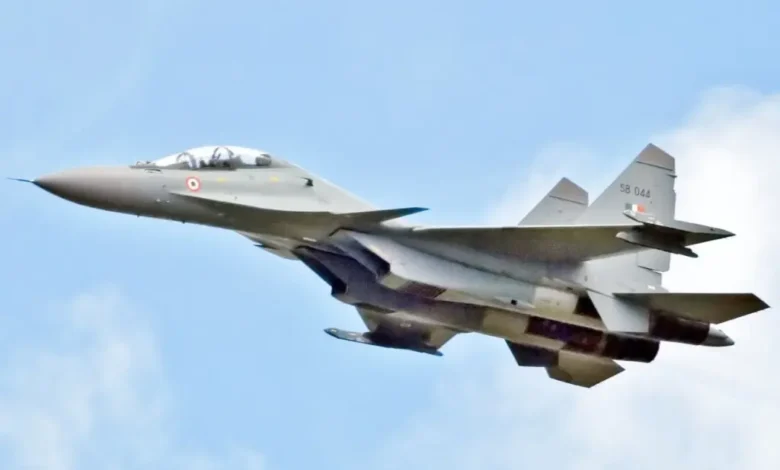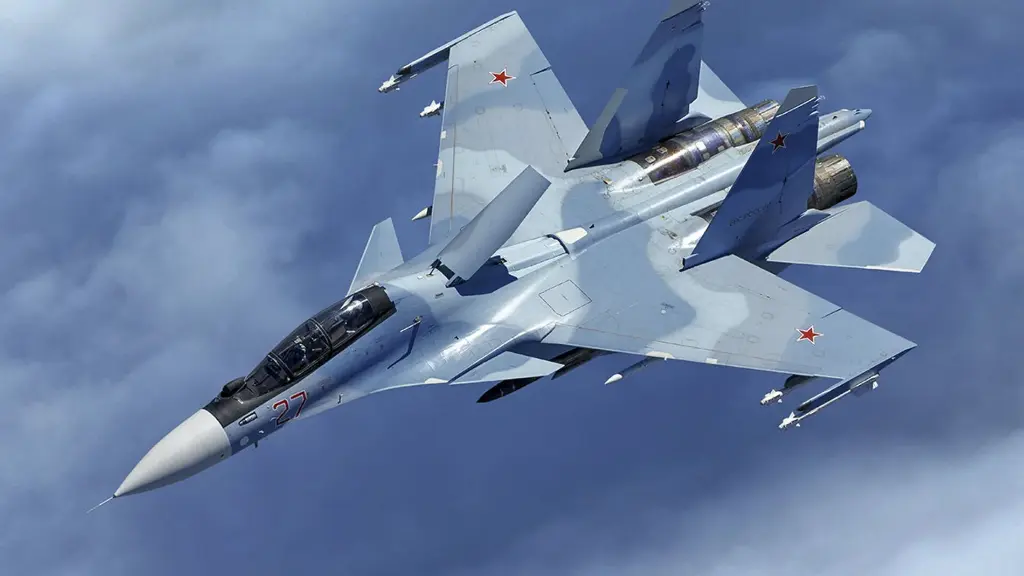Sukhoi Su-30

The Sukhoi Su-30 is a twin-engine, multirole fighter aircraft developed by Sukhoi for the Russian Air Force and export markets. Based on the Su-27 platform, the Su-30 features advanced avionics, extended range, and multirole capabilities. First flown in 1989 and introduced in 1996, the Su-30 is designed for air superiority, ground attack, and reconnaissance missions, making it a versatile platform for modern combat scenarios.
Fact Sheet
| Role | Multirole fighter |
|---|---|
| Manufacturer | Sukhoi |
| First Flight | 1989 |
| Service Entry | 1996 |
| Crew | 2 (pilot and weapons systems officer) |
Specifications
| Length | 21.9 m (72 ft) |
|---|---|
| Wingspan | 14.7 m (48 ft 3 in) |
| Height | 6.36 m (20 ft 10 in) |
| Empty Weight | 17,700 kg (39,021 lb) |
| Max Takeoff Weight | 34,500 kg (76,060 lb) |
| Powerplant | 2 × Saturn AL-31F turbofans |
| Thrust | 27,560 lbf (122.6 kN) per engine with afterburner |
| Max Speed | Mach 2.0 (2,120 km/h; 1,320 mph) |
| Service Ceiling | 17,300 m (56,800 ft) |
| Range | ~1,860 mi (3,000 km) combat radius |
| Rate of Climb | ~55,000 ft/min (280 m/s) |
Avionics & Armament
| Main Radar | N011M Bars PESA radar |
|---|---|
| Avionics | Advanced avionics suite, electronic warfare systems |
| Armament | One 30-mm GSh-30-1 cannon (150 rounds); Up to 12 external hardpoints for: – Air-to-air missiles (R-77, R-73) – Air-to-ground munitions (Kh-31, Kh-29, bombs) – Precision-guided bombs – External fuel tanks |
Notable Features
- Supermaneuverability with thrust vectoring engines (Su-30MKI variant).
- Multirole capability for air-to-air and air-to-ground missions.
- Advanced avionics for superior situational awareness.
- High payload capacity for extended combat missions.
- Widely exported to allied nations, including India, China, and others.

The Sukhoi Su-30 (NATO reporting name: Flanker-C/G/H) is one of the most successful and widely exported multi-role fighter aircraft in the world. Developed by Russia’s Sukhoi Aviation Corporation from the legendary Su-27 “Flanker” air superiority fighter, the Su-30 is a twin-engine, two-seat supermaneuverable jet designed for all-weather, air-to-air, and air-to-surface interdiction missions. It is particularly known for its long-range capabilities, heavy payload capacity, and impressive agility.
Origin and Evolution
The Su-30’s lineage traces back to the two-seat Su-27UB trainer variant. Recognizing the potential for a long-range, two-seat multi-role platform, Sukhoi began development in the 1980s. The first flight of a dedicated Su-30 prototype was on December 31, 1989, and it entered service with the Russian Air Force in 1992.
What makes the Su-30 family so significant is its highly modular design, allowing for numerous specialized variants tailored to the specific needs of different export customers. This has led to a diverse range of Su-30 models with varying avionics, engines, and weapon systems.
Key Characteristics and Capabilities
While specific features vary by variant, core characteristics of the Su-30 family include:
- Two-Seat Cockpit: The tandem two-seat configuration allows for a division of labor, with the pilot focusing on flying and maneuvering, and a Weapon Systems Officer (WSO) in the rear seat managing the complex radar, weapons, and electronic warfare systems. This greatly enhances mission effectiveness, especially for multi-role or long-duration missions.
- Long Range and Endurance: With a substantial internal fuel capacity and the ability to conduct in-flight refueling, the Su-30 boasts impressive combat range (typically around 3,000 km without refueling) and endurance, allowing for extended patrols or deep penetration strikes.
- Supermaneuverability: Many advanced Su-30 variants, such as the Su-30MKI and Su-30SM, are equipped with thrust-vectoring nozzles (like the AL-31FP or AL-41F1S engines) and canard foreplanes (small wings near the nose). These features provide exceptional agility at low speeds and high angles of attack, enabling “Pugachev’s Cobra” and other extreme maneuvers that can be tactically advantageous in close-range combat.
- Powerful Radar: Most modern Su-30 variants feature sophisticated radars. The N011M Bars passive electronically scanned array (PESA) radar (found on MKI/MKM/MKA/SM variants) is particularly renowned for its ability to track multiple air targets and perform ground mapping and targeting. More recent upgrades are incorporating Active Electronically Scanned Array (AESA) radars for even greater capability.
- Heavy Payload: The Su-30 can carry a massive external payload of up to 8,000 kg (17,600 lbs) on numerous hardpoints.
- Diverse Armament: It can deploy a wide range of Russian and sometimes foreign-sourced weaponry, including:
- Air-to-Air Missiles: R-27 (medium-range, radar-guided), R-73 (short-range, infrared-guided), and the more advanced R-77 (medium-range, active radar-guided).
- Air-to-Surface Missiles: Kh-29 (air-to-ground), Kh-31 (anti-radiation/anti-ship), Kh-59 (stand-off land attack), and in the case of the Indian Su-30MKI, the formidable BrahMos-A supersonic cruise missile.
- Precision-Guided Bombs: Various laser-guided and satellite-guided bombs (KAB series).
- Internal 30mm Cannon: A GSh-30-1 cannon for close-quarters engagements.
- Advanced Avionics: Modern variants feature advanced glass cockpits, helmet-mounted displays, and sophisticated electronic warfare (EW) suites for self-protection.
Key Variants and Operators
The Su-30 family is incredibly diverse, with the “MK” (Modernized, Commercial) suffix denoting export versions and subsequent letters indicating the customer or specific configuration.
- Su-30K: Initial export version, based on the Su-27PU (early Su-30 prototype).
- Su-30MKI (Modernized Commercial Indian): This is perhaps the most famous and capable export variant. Developed for India, it features:
- Canards and Thrust Vectoring: Enhancing its supermaneuverability.
- N011M Bars PESA radar.
- A mix of Russian, French (Thales HUD), and Israeli (Elta ECM, targeting pods) avionics.
- Currently, the Indian Air Force (IAF) operates around 260 Su-30MKIs, making it their backbone fighter. India is undertaking a major “Super Sukhoi” upgrade program for its MKI fleet, which will include new AESA radar (Virupaksha), more powerful Product 117S engines, enhanced avionics, and Manned-Unmanned Teaming (MUM-T) capabilities, aiming to keep them relevant for decades.
- Su-30MKM (Modernized Commercial Malaysian): A variant for Malaysia, similar to the MKI but with different French and South African avionics.
- Su-30MKA (Modernized Commercial Algerian): A variant for Algeria, incorporating French and Russian avionics. Algeria operates a significant fleet of these.
- Su-30MKK (Modernized Commercial Chinese): Developed for China, this variant (and its navalized Su-30MK2) focused more on strike capabilities. It does not have canards or thrust-vectoring.
- Su-30SM (Serial Modernized): Developed for the Russian Aerospace Forces and based heavily on the Su-30MKI (including canards and thrust vectoring). It has undergone significant upgrades, including the Su-30SM2 standard, which integrates components and technology from the Su-35S and Su-57, such as the AL-41F1S engines and improved radar/avionics. Russia operates over 130 Su-30SMs.
- Other Operators: Beyond the major operators listed above, Su-30 variants are also in service with:
- Angola
- Armenia
- Belarus (Su-30SM)
- Indonesia
- Kazakhstan (Su-30SM)
- Myanmar
- Uganda
- Venezuela
- Vietnam
Globally, over 630 Su-30s across all variants have been built, making it one of the most widely operated advanced fighter aircraft.
Combat Record
The Su-30 family has seen combat in various conflicts:
- Syria: Russian Aerospace Forces Su-30SMs have been deployed to Syria since 2015, providing air escort for bombers, conducting ground attack missions with precision-guided munitions, and maintaining air superiority.
- Ukraine: Russian Su-30SMs have been extensively used in the ongoing conflict in Ukraine, performing air superiority, ground attack, and escort roles. While some losses have occurred, the aircraft remains a significant asset in the conflict.
- Other Engagements: Su-30s have participated in numerous exercises with various air forces, often performing well against Western counterparts (e.g., Cope India exercises where Su-30MKIs reportedly performed favorably against F-15Cs and F-16s, although the specific rules of engagement in these exercises are crucial context).
The Sukhoi Su-30 continues to be a highly capable and actively developed multi-role fighter. Its adaptability, powerful systems, and widespread adoption by various air forces ensure its continued relevance as a formidable asset in modern air combat scenarios.



